
PREV ARTICLE
NEXT ARTICLE
FULL ISSUE
PREV FULL ISSUE
CNG TRITON XX SALE HIGHLIGHTS
Kerry Wetterstrom of Classical Numismatic Group forwarded this press release for the firm's Triton XX sale. Thanks.
-Editor
Classical Numismatic Group of Lancaster, Pennsylvania and London, England is proud to present Triton XX, a Public, Internet, and Mail Bid Sale to be held in conjunction with the 45th Annual New York International Numismatic Convention (NYINC) on January 10-11, 2017. The NYINC is held at the Waldorf-Astoria Hotel, located at 301 Park Avenue, New York, NY 10022, between 49th and 50th Streets. Triton XX features 1696 lots of ancient Greek, Celtic, Oriental Greek, Central Asian, Roman Provincial, Roman Republican, and Roman Imperial coinage. Additionally, there are featured selections of Byzantine, Early Medieval, Islamic, World, and British Coinage, as well as World Medals and a nice selection of large lots. The pre-sale estimate total for Triton XX is over $8 million. Triton XX is highlighted by a number of collections, which make up the majority of coins on offer. These collections include:
Lot viewing for Triton XX will begin on Sunday, January 8th, from 1PM until 7PM in the Carnegie Suite, located on the 18th floor of The Waldorf-Astoria Hotel. The complete lot-viewing schedule for Triton XX is:
Sunday, January 8, 2017 – 1PM until 7PM;
Auction lots will also be available for viewing at the Pennsylvania offices of CNG from Thursday, December 1st, 2016 until Friday, January 6th, 2017 by appointment only. Please note that CNG’s office hours will be limited during the holiday season. The auction sessions for Triton XX will be held in the Norse Suite, also located on the 18th floor of The Waldorf-Astoria Hotel. Triton XX will be conducted over four sessions with the morning sessions beginning promptly at 9:30 AM on Tuesday, January 10th, and Wednesday, January 11th, 2015, and the afternoon sessions will start at 2 PM on the same days. In addition, there will be an online, Internet-only, Session 5 for Triton XX, which CNG will be conducting as our Electronic Auction 389, and will open for bidding on December 14th, 2016. E-Sale 389 will feature over 1,400 lots, with a closing date of Wednesday, January 18th, 2017, and will include coins from some of the same collections listed above. Printed catalogs for Triton XX will be available after December 1, 2016. To order a catalog, please visit www.cngcoins.com. Catalogs are $75 to North American addresses, and $100 to the rest of the world. Payment may be made by U.S. $ check or Visa/MasterCard. Catalogues will be mailed to customers on CNG’s active mailing list. CNG is currently accepting consignments for its next Mail Bid and Internet auction, CNG 105, scheduled for May 10th, 2017. The consignment deadline is Friday, January 27th, 2017. For further details and any additional information, please contact CNG, Inc. at:
Classical Numismatic Group, Inc.
About the NYINC: Just a few of the individual highlights from Triton XX are:
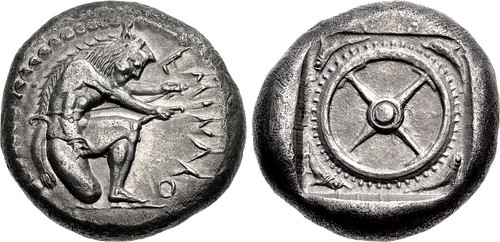
Lot 86 – SKYTHIA, Olbia. Eminakos. Circa 440-437 BC. AR Stater (21mm, 11.87 g). Herakles, nude but for lion skin draped over his head and back, kneeling right, stringing bow with both hands; EMINAKO to right / Studded wheel with four spokes; four dolphins swimming counterclockwise around; all within incuse square. Karyshkovskij Group I, α; V&K pl. 85, 6; Anokhin 167; SNG BM Black Sea 358 corr. (legend) = G. F. Hill, “Greek coins acquired by the British Museum in 1925” in NC 1926, 2; SNG Pushkin 52; SNG Stancomb 342; Boston MFA Supp. 79 = Jameson 2536; Frolova & Abramzon 248; Gillet 861; Hermitage Sale I 139; Kunstfreund 46; Rosen 147; Traité IV 1771. EF, toned, very slight granularity in spots. Rare, and among the finest known (better than the Prospero piece, which realized $45,000). Estimated at $30,000 Eminakos is known only from his coins. Most authors speculate that he was a local dynast based in Olbia, which is almost certainly the mint for this issue, as the types appear on other coins of Olbia and almost all examples known have been found in the vicinity of that city (see G. F. Hill, op cit, pp. 117–8). In his 1968 doctoral thesis, Karyshkovskij noted 21 known staters of this type, to which a few have been added over the past 48 years. It would seem, thus, that this is not an extremely rare coinage, but the vast majority are in public collections; they very rarely appear at auction – only two examples are in CoinArchives, sold in 2012 and 2014, over a decade after the previous example, the Kunstfreund specimen sold in Leu 76 in 1999.
Finest Known of Three Examples
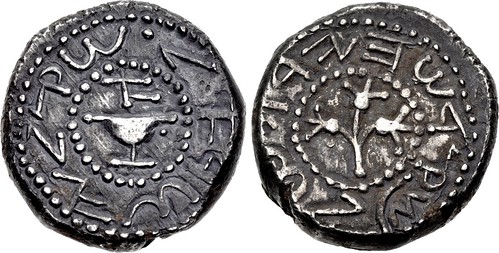
Lot 358 – JUDAEA, Jewish War. 66-70 CE. AR Shekel (22.5mm, 14.18 g, 11h). Protoype issue. Jerusalem mint. Dated year 1 (66/7 CE). Omer cup; “1” (date, in Hebrew) above, pellets flanking, “Shekel of Israel” (in Hebrew) around, between concentric dotted circle borders / Sprig of three pomegranates; “Jerusalem [the] holy” (in Hebrew) around, between concentric dotted circle borders. Meshorer 183; Kadman 1; Hendin 1352; Bromberg 56 = Shoshana I 20195 (same dies); Sofaer –; Spaer –. EF, toned, original patina, slightly off center on reverse. The third, and finest, known, one of which is in a public collection (Jerusalem). The Shoshana/Bromberg piece hammered at $925,000 in 2012. Estimated at $750,000 From an American collection. This is one of three known examples of a prototype for the shekel of the first year of the Jewish War, beginning May 66 (or a bit later), and it is therefore the first coin type of the renowned Jewish War shekels and half shekels. One specimen, discussed further below, is in the collection of the Israel Museum, Jerusalem. The second specimen was sold in Shoshana I at a hammer of $925,000; the same coin had been sold previously in 1991 as part of the Bromberg Collection, and sold there for $242,000. This third specimen is the only one of the three that has not been cleaned, and it retains a thin, attractive patina of the silver chlorides typically seen on the Jewish shekels. It is also the best struck of the three coins, while all three of them are slightly off-center on the reverse, this specimen shows more of the legend than the others. In the late 1970’s, Shab’an Wazwaz, a dealer in Old City Jerusalem, offered me a group of six shekels. Three were year 2, two were year 3, and the sixth coin was the first known example of this type: Asking price was $6,000. Mr. Wazwaz was a legitimate dealer, but did have the reputation of selling the occasional forgery, and so I rejected the deal and instead offered $4,000 for the five shekels, not including the sixth. At the time, this type had not been published, and Ya’akov Meshorer had seen the coin and said he believed it was not genuine. I was unable to discuss it with Meshorer, because he was not in the country during my visit. I was a “kid” only 10 years into my study, and it looked authentic to me, but I was in no position to put up $2,000 for a questionable coin. Upon his return from abroad, Meshorer reviewed the coin again and decided to buy it for the collection of the Israel Museum, where he was chief curator of archaeology as well as numismatics. (David Hendin, American Numismatic Society)
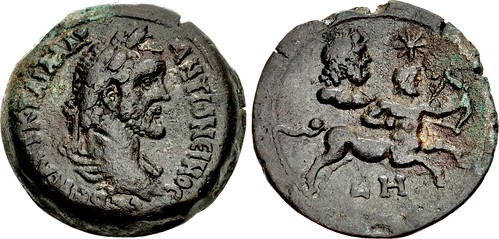
Lot 478 – EGYPT, Alexandria. Antoninus Pius. AD 138-161. Æ Drachm (33mm, 23.67 g, 11h). Zodiac series. Dated RY 8 (AD 144/5). AVT K T AIΛ A∆P ANTωNЄINOC CЄB ЄVC, laureate, draped, and cuirassed bust right / Jupiter in Sagittarius: Centaur galloping right, drawing bow and arrow, star above his head; above centaur, bust of Jupiter (Zeus) right with slight drapery; [L] H (date) below. Köln 1503; Dattari (Savio) 2973; K&G 35.263; Emmett 1693.8. Good VF, dark brown patina with touches of green. Rare. One of the finest known examples for the type. Estimated at $4,000 From the H. Mitchell Collection, purchased from R. M. Smythe (David Vagi), 18 November 1999. Alexandria saw an immense output of coinage during the eighth year of Antoninus Pius’s reign. The Zodiac drachms, mythological types, and a host of issues for the nomes appeared that year. One explanation for this activity centers on the celebration of the renewal of the Great Sothic cycle, the point when the star Sothis (Sirius) rises on the same point on the horizon as the sun. This cycle of 1461 years began early in the reign of Pius in AD 139, and apparently prompted a renewal in the ancient Egyptian religion, while the coin types also stressed the connections to the Greco-Roman Pantheon.
Published in Blanchet, Bahrfeldt, Babelon, and Biaggi
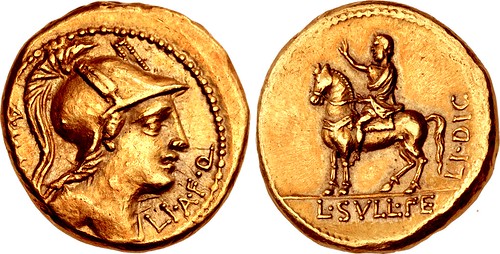
Lot 519 – A. Manlius A.f. 80 BC. AV Aureus (20mm, 10.75 g, 8h). Uncertain Eastern mint. Draped bust of Roma right, wearing crested helmet ornamented with two plumes, and earrings; A • MAN downward to left, LI • A • F • Q upward to right / Sulla, laureate and wearing sagum, left on horseback, raising right hand in acclamation; L • SVLL • FE in exergue, LI • DIC • upward to right. Crawford 381/1a (same rev. die); Sydenham 762 = BMCRR East 16; Calicó 20 (this coin illustrated); Biaggi 13 = Bahrfeldt 12/4 = A. Blanchet, Les monnaies romaines (Paris: 1896), p. 121, 9 = Babelon II 9 (this coin); Kestner –; RBW –. Near EF, warm reddish toning. Extremely rare, and the only issue naming Sulla as dictator. Estimated at $200,000 From the collection of a director. Ex Leo Biaggi de Blasys Collection, 13. This aureus, struck during the third consulship of the dictator Sulla in 80 BC, offers an intriguing glimpse of the Realpolitik of the Roman Republic in the early first century BC. The obverse depicts a purely Roman version of the goddess Roma, complete with the archaic Republican helmet decorated with a pair of plumes. The reverse features the statua Sullae, which was located near the Rostra in the Roman Forum, and which was dedicated by King Bocchus I of Mauretania to commemorate the role of Sulla (and Bocchus) in the capture of Jugurtha. It was the Jugurthine War (112-106 BC) that set in motion the subsequent period of internal political conflict between various generals and deep division within the Senate between the patricians and the novi homines, or "new men," all of which culminated in the civil wars of the second half of the century and the establishment of the Principate under Augustus. The coin's moneyer, A. Manlius A. f., also participated in the Jugurthine War. In addition to serving as a legatus to the Roman commander-in-chief, Gaius Marius (Sall.Iug. 86.1; 90.2; 102.23), he was appointed by Marius – along with Sulla – to meet with Bocchus, which resulted in the betrayal and capture of Jugurtha. Although his cognomen is unknown, Aulus Manlius was a member of the gens Manlia, one of the oldest and most patrician families of Rome. The gens boasted numerous holders of high office throughout the Republic, including a number of consuls. When the bloody civil war between Marius and Sulla broke out following the Social War (91-88 BC), Manlius allied himself with the conservative patricians who supported Sulla, rather than his old commander Marius, who was a novus homo. Nothing more is known of Manlius until 80 BC, when he struck this aureus. Why he did so remains the subject of speculation. A explanation is that the coin commemorates Sulla's resignation of the dictatorship he held the previous year. In keeping with his traditionalist sentiments, Sulla resigned his office (including disbanding his legions) and re-established consular government; he then dismissed his lictors and entered the Forum unprotected to give an account of himself to any citizen (Plut. Vit. Sull. 34). Thus, his action may have been viewed by his adherents (and certainly Manlius), as the victorious denouement of a great man who fought to preserve the values of the ancient Republic.
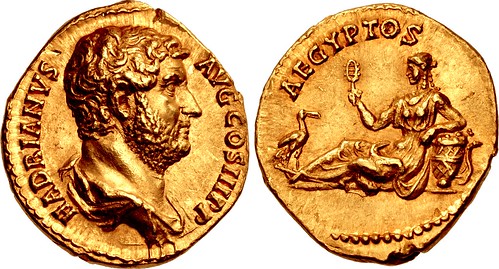
Lot 734 – Hadrian. AD 117-138. AV Aureus (19mm, 7.46 g, 6h). Rome mint. Struck AD 134-138. HADRIANVS AVG COS III P P, bareheaded and draped bust right / AEGYPTOS, Egypt reclining left, holding sistrum in right hand, leaning left elbow on basket around which is coiled a serpent; at feet, ibis standing right. RIC II 296c; Calicó 1190a (this coin illustrated); BMCRE 793 var. (ibis on column, no serpent); Biaggi –. EF, lustrous. Rare. Estimated at $75,000 From the Continental Collection. Ex Rauch 58 (28 October 1996), lot 288; Numismatic Fine Arts XVIII (31 March 1987), lot 474; Schewizerische Kreditanstalt 4 (3 December 1985), lot 498. This coin is part of interesting series struck late in Hadrian’s reign to commemorate his travels throughout the provinces of the empire. The emperor’s journey to Egypt was particularly fateful; while Hadrian was sailing along the Nile in October AD 130, his young lover, Antinous, fell into the river and drowned.
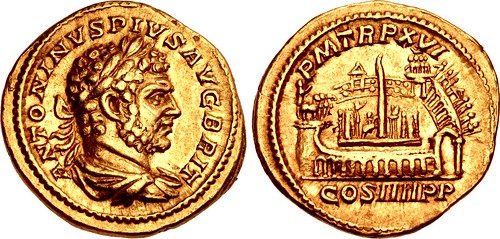
Lot 800 – Caracalla. AD 198-217. AV Aureus (20mm, 6.90 g, 6h). Rome mint. Struck AD 213. ANTONINVS PIVS AVG BRIT, laureate, draped, and cuirassed bust right / P M TR P XVI, COS IIII P P in exergue, view of the Circus Maximus, with spina, metae, and obelisk in center. RIC IV 211B = BMCRE p. 439, † corr. (rev. legend); Calicó 2710 (same rev. die as illustration); Biaggi –. Near EF. Extremely rare and important architectural type. Estimated at $75,000 While gladitorial combat is the sport that most people today would associate with ancient Rome, chariot races held at tracks, or circuses, were the real passion of the populace. The Circus Maximus (“largest” or “greatest circus”) lived up to its grand name, with modern scholars estimating that the building could hold some 150,000 spectators, or roughly three times the number of people that the Colosseum could accommodate (Pliny’s statement that the Circus could hold 250,000 appears to be an exaggeration). Caracalla renovated the Circus in AD 213, and rare aurei and sestertii were issued to celebrate the project. This artistic aerial view depicts the Circus as it would be seen from the Palatine Hill. According to Pliny, the Circus was established during the reign of the Tarquinius Priscus, Etruscan king of Rome (circa 616-579 BC), although a permanent structure may not have existed until 329 BC, when the starting gates (carceres) were erected. By the early 2nd century AD, the structure was very close to the form that we see on our coin. In the center of the Circus we find the spina (“spine”), upon which is the obelisk of the Pharaoh Ramesses the Great that Augustus brought to Rome and erected in the Circus (it is located today in Rome’s Piazza del Popolo). At each end of the spina is a meta, or conical column situated where the charioteers would make their harrowing turns, while an equestrian statue of Trajan and a shrine of Cybele can be found immediately to the left and right of the obelisk, respectively. In the foreground and to right are arcades and a prominent arched gate, while on the left we find the semicircular end of the structure, with the attic statuary of a triumphal arch of Titus visible. The temple of Sol and Luna, built into the seating, is visible on the far end of the structure, to the left of the obelisk’s peak. The coin cited in RIC and BMCRE was in Baldwin’s stock in 1927. The example plated in Calicó, with which our coin shares the same reverse die, was sold by Freeman & Sear in 2005 (FPL 10, no. 111), while another specimen was recently sold by Künker (Auction 270, lot 8855). Our coin may be only the third or fourth known, depending on whether or not the 1927 Baldwin’s piece is distinct from the other known examples.
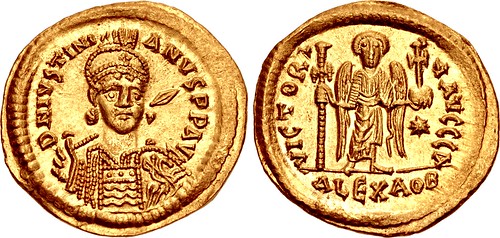
Lot 1043 – Justinian I. 527-565. AV Solidus (22mm, 4.45 g, 6h). Alexandria mint. Struck circa 527-538. D N IVSTINI–ANVS P P AV, helmeted and cuirassed bust facing slightly right, holding spear over shoulder in right hand, shield over left shoulder / VICTORI–A AVCCC, angel standing facing, holding long cross in right hand and globus cruciger in left; star in right field; A//ALEXAOB. Unpublished, but for other examples that have recently appeared on the market, see Gemini IX, lot 528; Lanz 151, lot 943; and Lanz 148, lot 167. Superb EF. Extremely rare and unpublished in the standard references. Possibly only the sixth known. Estimated at $50,000 From the Goldman Collection, purchased from Antiqua, August 2011. This type has only recently come to light and is of great importance. Previously only copper coins of Justinian were known from Alexandria, which feature the mintmark in Greek rather than Latin.
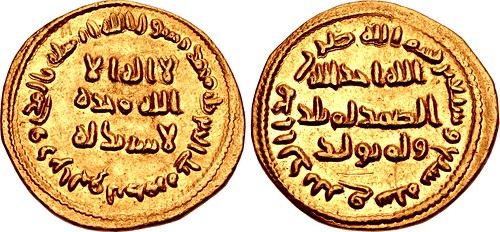
Lot 1138 – ISLAMIC, Umayyad Caliphate. temp. 'Abd al-Malik ibn Marwan. AH 65-86 / AD 685-705. AV Dinar (21mm, 4.25 g, 6h). Unnamed (Dimashq [Damascus]?) mint. Dated AH 77 (AD 696/7). First portion of the kalimat at-tawḥīd: lā ilāha illā-llāhu waḥdahu lā sharīka lahu (there is no god except Allah, and one [is] he; (there is) no partner to him) in three lines; in outer margin, the “Umayyad Second Symbol” (Sura 9 [al-tauba]:33): muḥammadur rasūlu-llāh arsalahu bi-’lhudā wa dīn al-haqq lī-yuzhirahu ’ala al-dīn kollihi walau kariha al-mushrikūn (Muhammad is the messenger of Allah; him He sent with guidance and true faith to make it prevail over all other faiths even though the polytheists may hate it) / The “Umayyad Symbol” (Sura 112 [al-ikhlas]) Āllah ahad Āllah āl-samad lam yalīd wa lam yalūd (Allah [is] One; Allah [is] the Eternal, the Absolute; not begetting and not begotten) in three lines; in outer margin, b-ismi-llāh zarb hazā āl-dinār fī sanat seb’ wa seb’īn (in the name of Allah struck this dinar in the year seven and seventy (after the Hijra)). AGC I 41; SICA 2, 1 (same dies); Walker, Arab-Byzantine, 186; Album 125; ICV 155. EF, hint of double strike, minor scratches in lower field of reverse . Very rare and the key date in the series. Estimated at $200,000 This is an exceptional opportunity to acquire a superb example of the Umayyad dinar struck in the year 77 of the Hijra. This iconic coin was the first of its kind to describe the tenets of the Islamic Faith rather than being issued on behalf of a political dynasty. It exercised an influence far beyond the borders of the Islamic Empire for over a thousand years. It drew a clear line between the coinage of the former rulers of the Levant, who were the Trinitarian Byzantines, and the monophysite Arabs. Its texts perfectly encapsulated the new Faith of Islam. The obverse field states the unique nature of God, and in the margin that Muhammad, as the messenger of God, was responsible for the spread of this belief. The field legend on the reverse expands on this by ruling out the incarnation of Christ as the Son of God. The margin emphasizes that the coin was struck in the name of God, rather than the Umayyad ruler, and shows the date of its striking in the new Hijra era. Thus, the legends encapsulated a vigorous response to the Byzantine gold solidus of Justinian II where an image of Christ was placed on the obverse and that of the Emperor grasping a cross on the reverse. History does not record the exact date at which the Caliph ‘Abd al-Malik bin Marwan introduced his new coinage, but because of the rarity of this issue the cataloguer suggests that it was probably toward the end of the year 77, perhaps for the pilgrimage season at the time of the ‘Eid al-Adha. All those who held examples of this coin in their hands, and the annual issues which followed after it, carried with them a powerful missionary document, which explained all that was necessary for a follower of the Faith to accept. In an age before modern communications, coinage was the most effective messenger that the government possessed to sway the hearts and minds of the people under its rule. CNG wishes to thank Robert Darley-Doran for his assistance in drafting the background note for this lot.
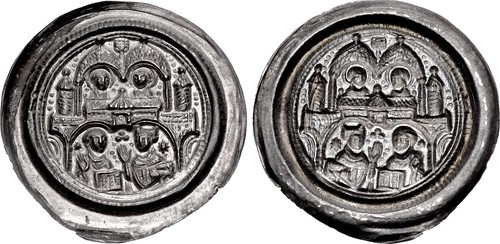
Danzig City View
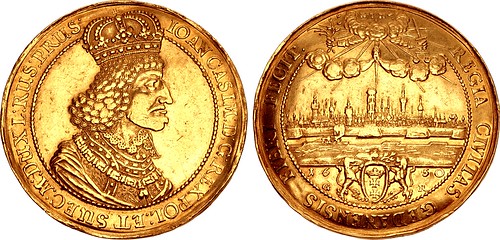
Lot 1358 – POLAND, Monarchy. Jan II Kazimierz. 1648-1668. AV 10 Dukaty (47.5mm, 34.81 g, 12h). Gdańsk (Danzig) mint; Gerard Rogge, mintmaster. Dated 1650 G R. IOAN CASIM : D : G : REX POL ET SUEC : M : DUX : L : RUS : PRUS :, crowned, armored, and collared bust right, wearing ruff / REGIA CIVITAS GEDANENSIS FIERI FECIT., view of city of Gdansk (Danzig) with scenes of immediate countryside; above, radiate tetragrammaton with four arms emerging from clouds: arm to left holding olive branch; arm to right holding sword and scales; below, two arms with hands clasped together in prayer; in exergue, royal coat-of-arms with leonine supporters; date and G R (mintmaster’s initials) flanking. D&S, Gedanensis, 353; MD D50a; Czapski 1925; Kopicki –; Gumowski –; KM 52; cf. Friedberg 26 (unlisted date). EF, minor scratches and edge marks. Extremely Rare. Estimated at $100,000
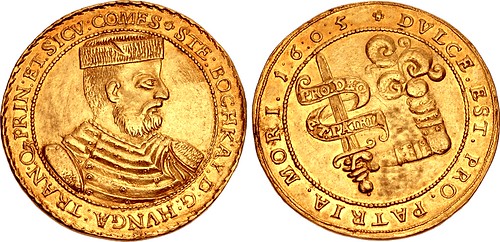
Lot 1394 – TRANSYLVANIA, Principality. István Bocskai. 1604-1606. AV 10 Dukát (40.5mm, 35.27 g, 1h). Nagybánya (Frauenbach / Baia Mare) mint (?). Dated 1605. * STE : BOCHKAY · D : G : HVNGA : TRAN : Q3 : PRIN : ET · SICV : COMES, armored bust right wearing short fur cap / * DVLCE · EST · PRO · PATRIA · MORI · 1 : 6 : 0 : 5 ·, armored arm emerging from clouds, holding sword with intertwined banner reading PRO · DEO/ ET · PATRIA. Resch 3; MBR 650; KM 19; Friedberg 305; Adams III 2675 (same dies). EF, toned. Estimated at $50,000 From the Princeps Collection.
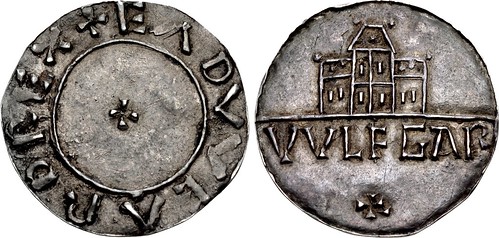
Lot 1531 – ANGLO-SAXON, Kings of Wessex. Edward the Elder. 899-924. AR Penny (20.5mm, 1.44 g, 10h). Minster type (BMC xiii). Mercia North West mint (probably Chester); Wulfgar, moneyer. Middle period, circa 910-915. + EΛDVVEΛRD REX, small cross pattée / Minster (Saxon church) on ground line above VVLFGAR; small cross pattée below. CTCE 342f (this coin); SCBI 9 (Ashmolean), 316 (same dies); BMC 111; North 667; SCBC 1075. EF, deeply toned. The reverse a masterpiece in numismatic design. One of only four specimens in private hands and with an illustrious pedigree. Estimated at $25,000 From the Dr. Andrew Wayne Collection. Ex ‘Charles’ Collection (Dix, Noonan, Webb 93, 26 September 2011), lot 1012 and front cover; Sir John Hanham Collection; V. J. E. Ryan Collection (Part II, Glendining’s, 22 January 1952), lot 752; G. C. Drabble Collection (Part I, Glendining, 4 July 1939), lot 405; Spink Numismatic Circular XXIX.9/10 (September-October 1921), no. 96458; C. M. Crompton-Roberts Collection; A. B. Richardson Collection (Sotheby, Wilkinson & Hodge, 22 May 1895), lot 41; The Hon. R. W. Marsham Collection (Sotheby, Wilkinson & Hodge, 19 November 1888), lot 163. 
Wayne Homren, Editor The Numismatic Bibliomania Society is a non-profit organization promoting numismatic literature. See our web site at coinbooks.org. To submit items for publication in The E-Sylum, write to the Editor at this address: whomren@gmail.com To subscribe go to: https://my.binhost.com/lists/listinfo/esylum All Rights Reserved. NBS Home Page Contact the NBS webmaster 
|